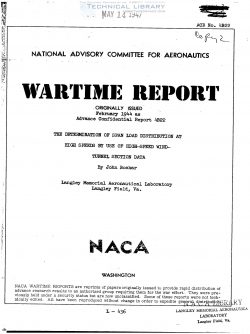naca-wr-l-436
- Version
- 52 Downloads
- 1.25 MB File Size
- 1 File Count
- April 3, 2017 Create Date
- April 3, 2017 Last Updated
The Determination of Span Load Distribution at High Speeds by Use of High Speed Wind Tunnel Section Data

SUMMARY
A tabular method is presented for determining the
span load distribution at high Mach numbers by utilizing
high-speed airfoil section data. The method, designated
the generalized method, is an easily applied process of
successive approxlmations by which a general application
of the lifting-line theory may be used to determine the
span load distribution for wings composed of sections
having arbitrary lift curves. An example is given to
show how this method is used. A comparison of span
load distribution obtained by the generalized method
using high-speed data is made with results obtained by
the strip-theory method using high-speed data and by
the conventional method of applying lifting-line theory,
which utilizes low-speed data.
The results of the computations indicate that the
loading changes associated with Mach number may be
great enough to require modification in the current
method of computing span loading for design purposes.
INTRODUCTION
In some recent high-speed airplane flights a number
of accidents and near accidents have occurred, which
could be associated, in part, with changes in wing span
load distribution at high Mach numbers. These changes
have been manifested by both inordinate changes in air-
plane stability and formation of permanent wing wrinkles
at load factors lower than should be expected on the
basis of static-test results.
Qualitative considerations of the effect of Mach
number on two-dimensional airfoils indicate that some
2
changes in loading are to be expected in the usual
operating lift range, because the thicker inboard sec-
tions of a typical wing would experience a compressi-
bility stall earlier than the outboard sections and would
consequently require the outboard sections to carry a
greater part of the load if the lift is to be maintained.
Except for some unpublished high-speed wind-tunnel re-
sults of wake measurements behind a tapered wing, which
verified the conclusion that stalling occurs earlier
on the root sections than on the tip sections, no direct
experimental data exist on the subject and the actual
magnitude of the span-loading changes has been question-
able.
Although designers are aware, therefore, that
changes occur in the section lift curves after the occur-
rence of a compressibility stall, airplane wings are
still built to carry the limit loads distributed in ac—
cordance with a lifting-line theory that includes the
assumption that the individual sections along the span
have a constant lift-curve slope throughout the entire
operating range.
The purpose of the present report is:
(1) To present a tabular method by which the
lifting-line theory may be easily applied to the deter-
mination of the span load distrioution of a wing, re-
gardless of the type of section lift curves.
(2) To present, for two hypothetical wings, com-
parisons of the span load distribution as determined by
means of
(a) The strip theory, in which high-speed
wind—tunnel data are used
(b) The conventional application of the
lifting-line theory, in which low-
speed wind-tunnel data are used
(c) The generalized method of applying lifting-
line theory, in which high-speed'wind-
tunnel data are used
5
(5) To present an example showing how the general-
ized method may be used to determine span load distribu-
tion at high speeds.
| File | Action |
|---|---|
| naca-wr-l-436 The Determination of Span Load Distribution at High Speeds by Use of High Speed Wind Tunnel Section Data.pdf | Download |

Comment On This Post